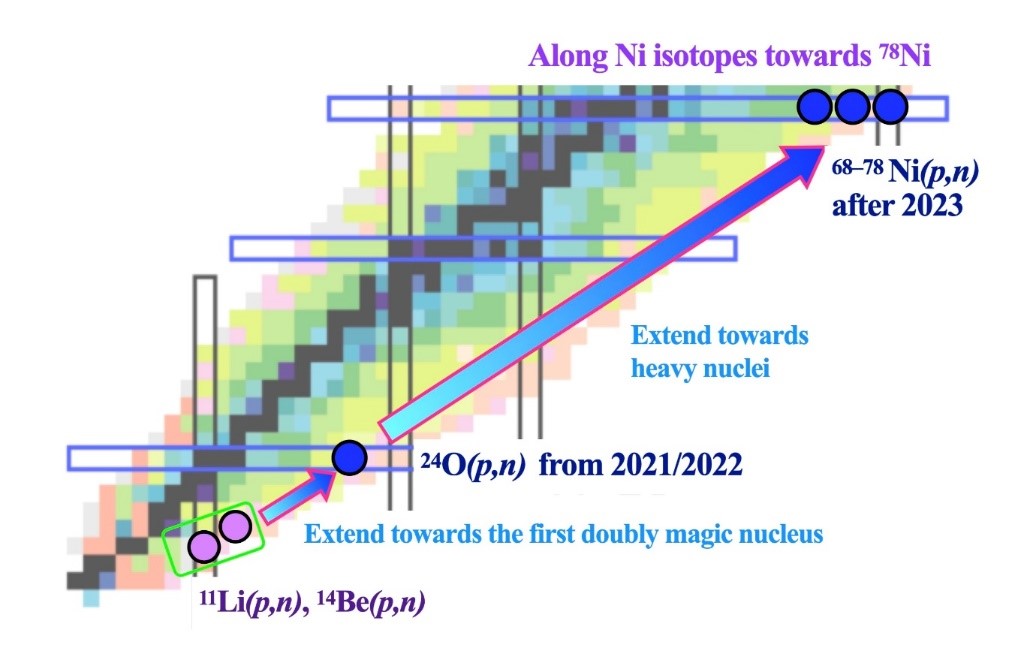Direct reactions that selectively excite a minimal number of nucleonic degrees of freedom are of great interest, since they provide a tool for identifying the microscopic or single-particle structures of nuclei. Below are a few experimental areas of interest in the perspective of nuclear reactions, which are being handled and developed by CENS researchers.
A 93Zr + p reaction experiment at 27 A·MeV was carried out at RIBF-RIKEN using the OEDO beamline to confirm the feasibility of nuclear transmutation of the long-lived fission product 93Zr at low energies as well as to accumulate the nuclear data. The results are compared with the previous experimental data at higher reaction energies and the reaction code TALYS. Since the calculation results describe rather well the experimental data, the reaction mechanisms and reaction channels involved in the production of different isotopes are being corroborated.
On the other hand, a spectroscopy experiment on 80Zr is being proposed to study shape coexistence in this N = Z = 40 nucleus. The approach is to search for new states in the excited band, in particular 02+ and 22+, employing the energy-dissipation reaction at low energy (80Y + 𝑝 → 80Zr + 𝑛), and the in-beam γ-ray spectroscopy which accompanies the OEDO setup.
The lowest-lying cross-shell states in the neutron-rich isotopes of carbon are being investigated to provide spectroscopic information and verify the effect of specific components of effective interactions on the shell structure. Those states have a hole in the p-shell, and their energies are significantly influenced by the valence proton-neutron, neutron-neutron, and/or neutron-hole interactions.
In a neutron-rich isotope 17C, the magnetic dipole transition strength B(M1) from the 1/2+ excited state to the 3/2+ ground state was shown to be anomalously retarded compared to the B(M1) from the 5/2+ excited state to the 3/2+ ground state. This was explained by the π + ρ meson exchange tensor interaction in the p-sd cross-shell interaction.
In order to investigate the effect of the π + ρ meson exchange tensor interaction in the odd-A carbon isotope 17C, an experiment was performed using the SAMURAI spectrometer at RIKEN. The one-neutron knockout reaction at 245 A·MeV populated the p-shell hole-like states of 17C. The results are being analyzed and combined with the cross-shell states of the neighboring odd-A carbon isotopes 15,19C in order to test a range of shell-model Hamiltonians.
Research on dynamic properties of unstable nuclei, which manifest themselves in high excitation energies (>10–15 MeV), are in the very early stage worldwide. CENS is involved in the investigation of nuclear matter by giant resonances in the spin-isospin channel, with an emphasis on isospin asymmetric nuclear matter in exotic nuclei far from the valley of stability. The spin-isospin collectivity in atomic nuclei possesses an unparalleled degree of freedom of motion. Collective spin-isospin excitations are a powerful probe of nuclear matter properties, which are also important for the study of neutron stars. The most striking feature of spin-isospin response of nuclei in connection to the pion-exchange (στ operator) is the collective effect, called the Gamow-Teller Giant Resonance (GTGR).

Figure 1. Experimental setup of (p,n) charge exchange reactions with radioactive isotope beams at RIBF, RIKEN. CENS is actively involved in the use of the PANDORA detector and the SAMURAI spectrometer for the study of spin-isospin responses of unstable nuclei.
The (p,n) charge-exchange reactions in inverse kinematics and at intermediate beam energies (E >100 A·MeV) with small scattering angles provide the best and only efficient tool to study the Gamow-Teller excitation of the unstable radioactive isotopes in a wide excitation energy region (up to 50-60 MeV), i.e. there is no restriction to low excitation energy regions due to Q-value limitation. The combined setup of a low-energy neutron time-of-flight counter (PANDORA) and the SAMURAI magnetic spectrometer, together with a thick liquid hydrogen target allows measurements with high luminosity (see Fig. 1). SAMURAI is used for tagging the reaction residues with many relevant decay channels. In missing-mass spectroscopy, the kinematics is reconstructed from the energy and recoil angle of neutrons.
As the first step of the experimental program (SAMURAI30), a measurement on 11Li and 14Be was performed in 2018. Preliminary results show the discovery of strong collectivity and new Gamow-Teller resonances in these nuclei. The plan is to conduct background-free studies of collectivity in medium heavy nuclei along the neutron drip line, starting from systematical studies on 24O and towards the extremely exotic 78Ni, both of which are neutron-rich doubly magic nuclei (see Fig. 2), A key requirement is to dramatically improve the neutron background removal at the online data acquisition stage.

Figure 2. Research plan of (p,n) reaction studies on neutron-rich nuclei at CENS.